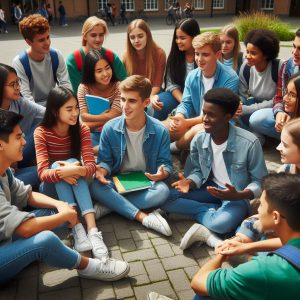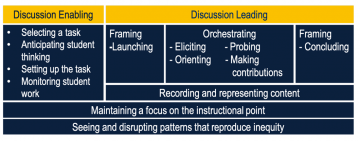What are classroom discussions?

Remember: Discussions can occur outdoors!
Classroom discussion can be defined as an oral activity where teachers and students develop together a specific curriculum content or competency through each other ideas. “The purposes of a discussion are to build collective knowledge and capability in relation to specific instructional goals and to allow students to practice listening, speaking, and interpreting, agreeing and disagreeing” (Teaching Works, 2022, May 2). In this sense, students use the ideas, words, explanations, and interaction with their teacher and peers as a resource for their own learning.
Classroom discussions are not merely to help students answer a question but to establish a conversation. This conversation may begin with a provocation, have a beginning, a sequence of processes, and an end or closure. What happens during the process is essential to developing the content and competencies of the curriculum and achieving teaching goals. Differing opinions, moderating interaction, taking turns, etc, are essential to developing student competencies and helping students to deeply explore content. Therefore, classroom discussions are a teaching and learning process that believes that students will accomplish curriculum goals together, through the process of sharing ideas (Teaching Works, 2022, May 2). Well-designed and orchestrated class discussions can help build classroom community.classroom community (links to post in this blog).
Classroom discussions can occur in both synchronous and asynchronous contexts. When planning an asynchronous discussion, teachers should consider the ability of students to self-regulate and manage the discussion. When discussing critical issues, the teacher may need to monitor and help guide the discussion. The Bell Foundation provides some suggestions for how to improve classroom talk that can improve students’ ability to participate in synch and asynch discussions.
Why are classroom discussions important?
 Classroom discussions are important because they develop both academic and non-academic skills in students. Communicating is essential to living in the current society and developing a healthy democracy. Being able to share, justify, defend, listen, and understand diverse perspectives and ideas is one of the most important competencies that human beings use in our current world. Hence, students need to learn these skills to be successful in their adult life.
Classroom discussions are important because they develop both academic and non-academic skills in students. Communicating is essential to living in the current society and developing a healthy democracy. Being able to share, justify, defend, listen, and understand diverse perspectives and ideas is one of the most important competencies that human beings use in our current world. Hence, students need to learn these skills to be successful in their adult life.
Moreover, classroom discussions support student development during their school years. Through classroom discussions, students can learn to make sense of complex ideas and organize their thoughts. Students can also develop the confidence to present their views and use evidence to justify them. Finally, classroom discussions can support teachers to reveal students’ conceptions and misunderstandings about a topic, helping them to identify contents and concepts that need to be better explained in a lesson.
However, developing rich classroom discussions is a complex task that may generate several problems if teachers do not conduct the process well. Teachers should know how to value different views and pay attention to each child’s needs. Therefore, the challenge (and secret) is to be conscious of all micro details involved in classroom discussions, as we will show next.
What are elements of a rich classroom discussion?
The Teaching Works Team (2022, May 2) from the teacher education program of the University of Michigan defends that teaching practices should be unpacked in chunks or elements to support novice teachers to develop these skills. In this sense, they divide the task of developing classroom discussion into several parts and elements, detailing what teachers should pay attention to in each part. In the next sections, we will details these steps and elements as well as complement them with additional resources and orientations.

Source: (Teaching Works Team, 2022, May 2)
Preparing for a discussion
1. Selecting a task:
Teachers should choose tasks, texts, and materials that allow multiple views, discussions, and solutions for a topic/question, encouraging students to explore different possibilities and arguments. Teachers may need to adapt a task to support multiple views and disrupt inequalities.
2. Anticipating student thinking:
Teachers should think about possible questions, mistakes, or understanding that students may have about the topic. This means both activating previous knowledge but also anticipating problems that may deviate students’ attention from the curriculum goals in that classroom discussion.
3. Setting up the task:
Teachers should select the purpose of the activity and prepare the orientations to support students’ work. In this sense, teachers also should plan the moments for students to work independently, in small groups, or with the whole class as well as the resources needed to develop the discussion.
Conducting the Discussion in class
1. Launching the discussion:
-
- Introducing the topic: teacher should clarify to students the purposes of the class, and/or activate previous knowledge. A way of starting developing these points is throughout hooks (links to post in this blog). Teachers may also pose open-end questions/ issues (links to post in this blog) to introduce the topic without restricting the possibility of solutions.
- Reviewing norms and routines: It is also important to build a classroom environment that makes students feel safe to discuss any topic and expose their opinion and knowledge. In this sense, teachers should build classroom norms and routines (links to post on teachingworks blog) and remember these rules before starting a new classroom discussion.
2. Orchestrating the discussion:
Teachers should pay attention to a couple of elements and tasks that will create thinking routines to explore and deepen their understanding of a topic. The following elements may happen in a different order but, according to Harvard’s Project Zero, they should be part of any Thinking Routine (links to Harvard’s Project Zero) chosen by teachers:
-
- Eliciting the discussion: teachers should state the multiple ideas that their students are bringing, helping them to see several points and arguments during the discussion.
- Orienting students’ attention: teachers should ask to students pay attention to specific ideas and contributions of their peers, encouraging them to learn with each other.
- Encouraging student participation: teachers should encourage all students to expose their ideas and control who ideas have been highlighted or ignored. It helps that classroom discussion not only become richer since diverse ideas will be developed but also supports decreasing inequity among students.
- Probing new questions: teachers should put new questions that support students to explore and deepen the topic, move to the next learning step process, or summarize what they have discussed.
- Making contributions: teachers should make contributions or introduce ideas/ concepts that were not brought by students but are essential to achieve the purposes of the discussion. If possible, teachers should connect these new ideas/concepts with what has already been discussed validating students’ contributions and establishing connections with previous knowledge.
3. Concluding the class discussion:
-
- Supporting summary: teachers should support students to summarize and remember what has been discussed, helping to establish the most relevant points worked during the class and issues that they will develop in the next classes.
- Acknowledge student contribution: teachers should highlight, with examples, how students’ ideas were essential to developing both content and competencies during the class.
4. Evaluating (after the discussion)
The final step is to reflect on what has happened in the classroom discussion to evaluate what works (or not) and how to improve future discussions.
Elements to consider as you plan, conduct and reflect
1. Maintaining a focus on the instructional objectives: teachers should always direct each student’s intervention to build some knowledge or example that will help to achieve content and competencies goals.
2. Monitoring students’ work: teachers should pay attention to what students are discussing in their groups and which ideas/ people are been highlighted. In this sense, teachers will be able to use students’ work to develop the content and prevent inequalities or bias in the discussion.
3. Seeing and disrupting patterns that reproduce inequalities: teachers should make interventions to stop patterns that may generate inequalities. These interventions do not need to be explicit. For example, teachers can use the work of a student who may not always be recognized as one of the more advanced or capable students in the class to exemplify a topic, helping to improve student status among his/her peers.
4. Recording the representation of content: teachers might record (on the board to the whole class or just to themself) what students are saying during the whole process because it can support the teaching and learning process. Students might also take notes as the discussion ensues. The notes can be used for formative assessment to help teachers understand students’ struggles and misconceptions, or to help with review to demonstrate student thinking or rationality and understanding of an issue. Teachers might find strategies to make student learning visible (Project Zero). Recording could take the form of a digital whiteboard (link to post in this blog) for all to see or for future reference, sorting & classifying ideas, etc.
Strategies to increase classroom engagement
There are many ways to design and lead a discussion to support more active classroom engagement. Teachers should also consider context including the age, background, needs and preferences of their students.
- In her blog, teacher Jenniffer Gonzales also provides some suggestions. You might also listen to the Cult of Pedagogy #28 Class Discussion Strategies podcast (see embed below).
- Liberating Structures provides a menu of varied activities for discussion and group work.
- Harvard’s Project Zero offers Thinking Routines that teachers can implement across grade levels and across the curriculum.
- The Teaching Works Team from UMichigan, offers an open library of Curriculum Resources that include strategies to support teaching in specific aspects of the curriculum and for more interdisciplinary approaches.
- The Bell Foundation is a charity that seeks to . The Bell Foundation website contains frameworks for discussion including video demonstrations and lesson plans for structures including ‘Information Gap’ activities such as JigSaws.
How might challenging or high-stakes topics be addressed?
Classroom discussions about challenging or complex topics need extra teachers’ attention because unexpected reactions may appear and some rules should be established to guarantee respect. The University of Michigan has prepared a specific orientation on how to conduct classroom discussions about challenging or high-stakes topics (UMich). Moreover, Edutopia discusses how classroom norms can support teachers during challenging discussions.
What can classroom discussions look like in each content area?
Teaching Works Team (2022, May 2) from the teacher education program of the University of Michigan has many specific tips and classroom resources for different subjects:
Additional Resources:
The courses below bring many classroom videos as examples of how to conduct good classroom discussions. They break down real situations and show how teachers dealt with these, conducting rich classroom discussions:
University of Pennsylvania (Coursera):
University of Michigan:
References:
Project Zero (2022, April 30). Project Zero’s Thinking Routine Toolbox. Harvard Graduation School of Education. http://www.pz.harvard.edu/
Liberating Structures (2022, April 30). Liberating Structures Menu. https://www.liberatingstructures.com/ls-menu/
Rochester Community Schools (2022, April 30). Think from the middle. Discourses Strategies. http://www.rcsthinkfromthemiddle.com/discourse-strategies.html
Teaching Works (2022, May 2). High-Leverage Practices. Teaching Works. https://www.teachingworks.org/work-of-teaching/high-leverage-practices.
Guest post by Peer Tutor Ariane Faria dos Santos (Ph.D. EDCP), May. 2022; edited Y.Dawydiak April 2024

